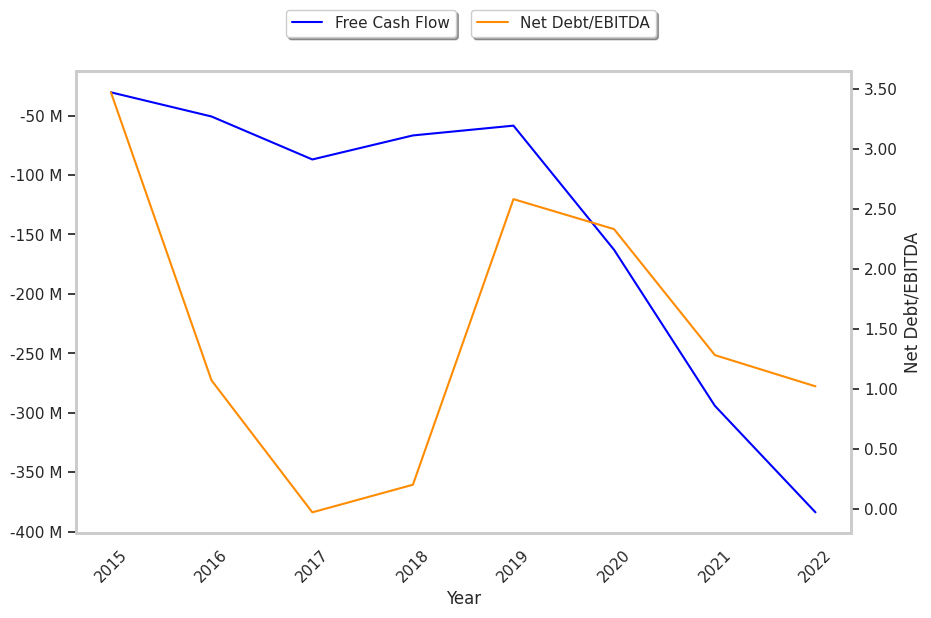Natera was one of the market's biggest losers today, losing 11.3% of its value and underperforming the S&P500 and Dow Industrial composite indices by 10.0% and 11.0% respectively. The mid-cap Health Care company ended the day at $39.76, closing in on its 52 week high low of $34.0 and is 45.08% below its average target price of $72.4. Over the last 12 months, Natera is down -7.0%, and has underperformed the S&P 500 by 27.0%. The stock has an average analyst rating of buy.
Natera does not publish its forward or trailing price to earnings (P/E) ratio because the stock has negative forward and trailing earnings per share (EPS) values at $-2.72 and $-5.02 respectively. Since P/E ratios are share price divided by earnings per share, Natera has a negative P/E ratio, which is not meaningful besides the fact that it indicates the company is not currently profitable.
When it comes to new businesses -- especially those operating within the technology sector -- investors are often willing to overlook prolonged periods of negative earnings and inflated valuations. But not so in the Health Care sector, which has an average P/E ratio of 24.45. If Natera cannot improve its earnings picture soon, it's unlikely that investors will stay onboard -- unless there are other factors in favor of the business's outlook.
Another metric for valuing a stock is its Price to Book (P/B) Ratio, which consists in its share price divided by its book value per share. The book value refers to the present value of the company if it sold all its tangible assets and paid off all debts today. Natera's P/B ratio of 7.61 indicates that the market may be overvaluing the company when compared to the average P/B ratio of the Health Care sector, which is 4.16.
Natera is likely to attract many investors on the basis of its strong gross margins, which indicate that it either has an exceptional competitive advantage, or that its particular product or services involve very few direct costs:
| Date Reported | Revenue ($ k) | Cost of Revenue ($ k) | Gross Margins (%) | YoY Growth (%) |
|---|---|---|---|---|
| 2023-03-01 | 820,222 | -456,256 | 44 | -10.2 |
| 2022-02-25 | 625,486 | -318,418 | 49 | 2.08 |
| 2021-02-26 | 391,005 | -203,620 | 48 | 14.29 |
| 2020-03-02 | 302,328 | -175,470 | 42 | 16.67 |
| 2019-03-15 | 257,654 | -166,055 | 36 | 5.88 |
| 2018-03-15 | 210,939 | -139,596 | 34 |
- Average gross margins: 42.2 %
- Average gross margins growth rate: 0.1 %
- Coefficient of variability (lower numbers indicate more stability): 14.6 %
Don't let the above fool you. Such high gross margins need to be considered alongside the company's operating margins, which take into account overhead:
| Date Reported | Total Revenue ($ k) | Operating Expenses ($ k) | Operating Margins (%) | YoY Growth (%) |
|---|---|---|---|---|
| 2023-03-01 | 820,222 | -905,006 | -66 | 12.0 |
| 2022-02-25 | 625,486 | -775,242 | -75 | -36.36 |
| 2021-02-26 | 391,005 | -403,662 | -55 | -27.91 |
| 2020-03-02 | 302,328 | -257,533 | -43 | 2.27 |
| 2019-03-15 | 257,654 | -206,227 | -44 | 31.25 |
| 2018-03-15 | 210,939 | -205,370 | -64 |
- Average operating margins: -57.8 %
- Average operating margins growth rate: -0.5 %
- Coefficient of variability (lower numbers indicate more stability): 22.1 %
We can see that in fact, Natera's significant overhead eliminates its profits from sales entirely. The company is not profitable.
Our final point of analysis is Natera's free cash flow. While earnings and margins are calculated on the basis of a company's delivered goods, they do not actually represent physical payments that flow into the coffers. The actually money that the company has -- minus its capital expenditures -- is reported as its free cash flow, which for Natera is as follows:
| Date Reported | Cash Flow from Operations ($ k) | Capital expenditures ($ k) | Free Cash Flow ($ k) | YoY Growth (%) |
|---|---|---|---|---|
| 2023-03-01 | -431,501 | -47,697 | -383,804 | -30.45 |
| 2022-02-25 | -335,236 | -41,030 | -294,206 | -80.6 |
| 2021-02-26 | -182,512 | -19,604 | -162,908 | -178.59 |
| 2020-03-02 | -63,444 | -4,968 | -58,476 | 12.33 |
| 2019-03-15 | -70,581 | -3,880 | -66,701 | 23.27 |
| 2018-03-15 | -96,792 | -9,867 | -86,925 |
- Average free cash flow: $-383804000
- Average free cash flow growth rate: -0.0 %
- Coefficient of variability (lower numbers indicating more stability): 318659471.3%
Free cash flow represents the money that Natera can use to either reinvest in the business or to reward its investors in the form of a dividend. Since the company's most recent cash flows are negative, it comes as no surprise that investors do not get a dividend.
In conclusion, Natera may be unattractive to investors with a low risk tolerance or a long term investment horizon. Stocks such as these may offer strong returns in the short term, but for now the long term potential of the company is not substantiated -- by the numbers, at least.



